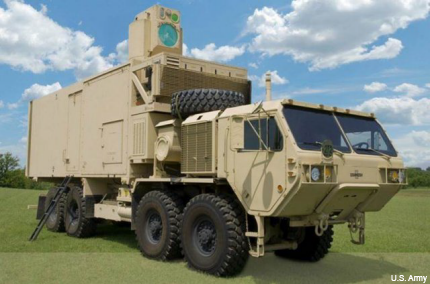Army preparing HEL laser gun for live-fire test
The High Energy Laser system, which has been advancing for years, would target rockets, drones, cruise missiles and other munitions.

The HEL system aboard its mobile demonstrator in an earlier test at White Springs.
The Army is planning a live-fire test of its High Energy Laser, or HEL, weapons system this fall at White Sands Missile Range, in an effort to test the current state-of-the-art in a technology that has been advancing for the last 15 years.
The service has issued a solicitation asking industry for information and recommendations on laser technology, and to look for potential participants in the demonstration. The Army said prizes of between $1 million and $5 million could be awarded to the most successful participant.
The Army, like the other services, have been working on developing laser, or directed-energy, systems primarily as a defensive weapon. The Navy’s first shipboard laser gun, deployed last year in the Persian Gulf, would be used against incoming drones, small aircraft or high-speed boats. For the Marines, the Office of Naval Research is developing a smaller, vehicle-mounted laser that would target drones.
The HEL system would be bigger than the one being built for the Marines, and have a wider range of targets. In the recently released 2016 Defense budget request, the Army asked for $43 million for its “high-energy laser program to demonstrate laser technology focused on defeating rockets, artillery, mortars, unmanned aircraft and cruise missiles.”
Research on HEL dates to its predecessor, the Tactical High Energy Laser, or THEL, which shot down its first artillery rocket in 2000 and over the next five years continued with a 90 percent success rate against rockets its tests, according to the Army. But officials—it was jointly developed by the Army’s Space and Missile Defense Command and the Israel Ministry of Defense, intended for use long Israel’s northern border—decided not to deploy it because THEL used toxic chemicals in its operation, which caused system reliability, logistics, cost and safety problems.
Researchers decided to focus instead on solid state lasers that relied only on electricity for power, and began coaxing what was at first an immature technology lacking in ruggedness into a viable weapon. By 2009, contractor Northrop Grumman had demonstrated a laser with a record power of 100 Kilowatts, which is sustained for several minutes.
Other successful tests have followed, including one last year in which the HEL Mobile Demonstrator (a term that included reference to the large truck on which it sits) engaged more than 150 targets in a demonstration by contractor Boeing and the Army at Elgin Air Force Base, Fla.
Those tests were conducted using a relatively low-power 10 kilowatt beam. The next step, officials said at the time, might not hit that 100 kilowatt record, but would be in the range of 50 to 60 kilowatts.



